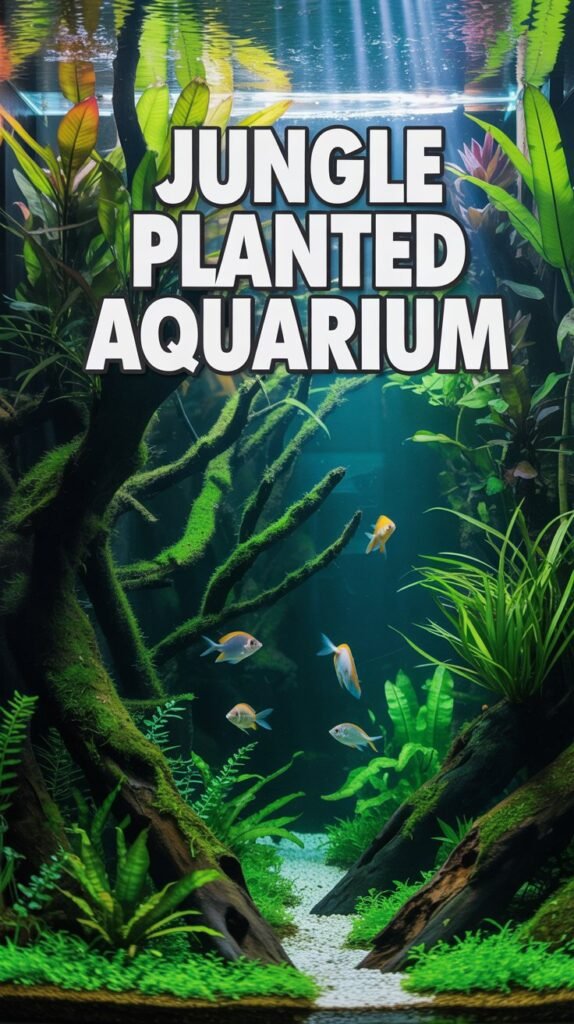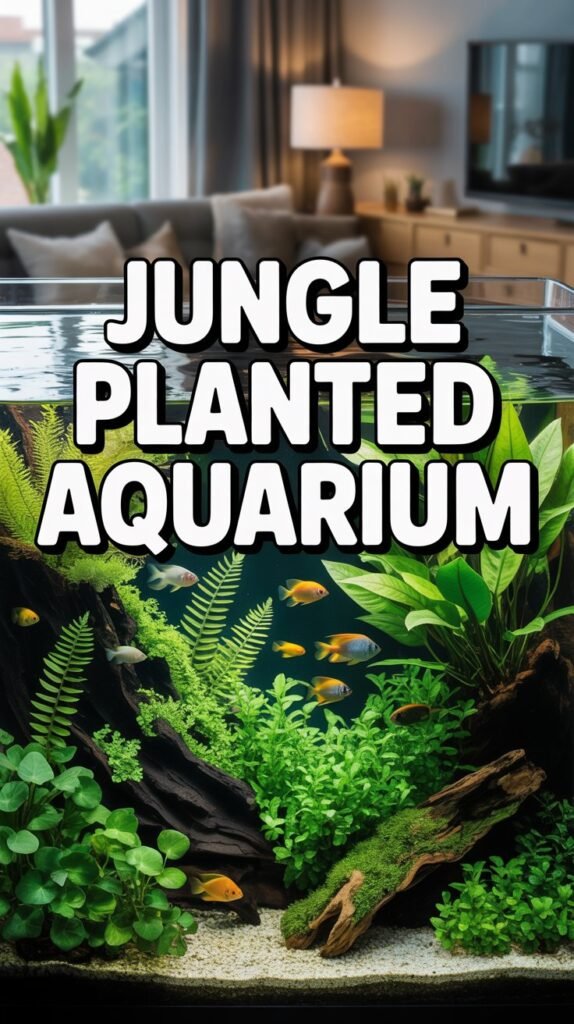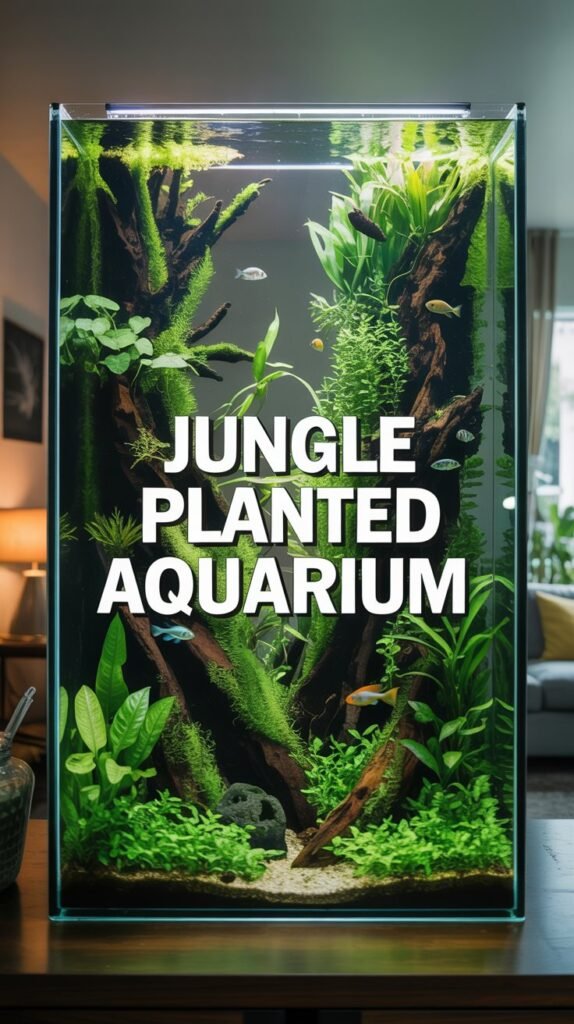If you’ve ever dreamed of a lush, vibrant underwater world that looks like a slice of the tropical rainforest, then a jungle planted aquarium is your perfect aquascaping style. Unlike the structured Dutch style or minimalist nature aquariums, the jungle aquarium celebrates chaos, diversity, and raw natural beauty — where plants grow wild, fish swim freely, and nature takes the lead.
In this complete guide, we’ll explore everything you need to know about creating a jungle planted aquarium, including setup tips, best plant species, lighting, CO₂, maintenance, aquascaping ideas, and expert FAQs. Whether you’re a beginner or seasoned aquarist, this guide will help you design a thriving underwater jungle that radiates life and natural charm.
What Is a Jungle Planted Aquarium?
A jungle planted aquarium is an aquascaping style designed to mimic the dense, untamed look of a natural tropical rainforest submerged underwater. It features thick vegetation, tall plants, tangled roots, and diverse textures — creating a wild, natural ecosystem.
Unlike other aquascaping approaches, the jungle aquarium embraces organic growth rather than strict design rules. Plants are allowed to grow freely, filling the tank and creating a natural sense of depth and mystery.

Key Characteristics of a Jungle Planted Aquarium
- Dense, Wild Growth – Plants grow freely without frequent trimming.
- Tall Background Plants – Long stems and broad leaves dominate the back and sides.
- Natural Layout – Randomness is intentional; no symmetry or “streets” like Dutch aquariums.
- Variety of Textures – A mix of fine, broad, and floating plants creates contrast.
- Dark, Organic Substrate – Mimics the look of forest soil or riverbeds.
- Driftwood and Roots – Adds authenticity and natural structure.
- Shade and Light Play – Light filtering through floating plants enhances realism.
- Balanced Ecosystem – Ideal habitat for tropical fish, shrimp, and snails.
The goal is to recreate an authentic slice of a tropical river or jungle stream, where every element — from roots to floating leaves — feels alive and untamed.
Why Choose a Jungle Planted Aquarium?
Here are a few reasons why aquarists love the jungle style:
1. Natural Aesthetic Appeal
The jungle aquarium’s dense, wild layout creates a sense of natural wonder. It’s as close as you can get to a real aquatic jungle inside your home.
2. Perfect Habitat for Fish
The thick vegetation provides shelter, breeding areas, and natural hiding spots, reducing fish stress and promoting healthier behavior.
3. Stable Water Conditions
With abundant plants, the tank naturally maintains biological balance — absorbing nitrates and stabilizing oxygen and CO₂ levels.
4. Low Maintenance (in the Long Run)
Once established, jungle aquariums require less trimming and interference. Plants manage nutrient balance naturally.
5. Eco-System in Harmony
It encourages biodiversity — plants, snails, shrimp, and fish coexist just like in the wild.
Planning Your Jungle Planted Aquarium
Creating a natural jungle environment requires thoughtful preparation. Here’s how to plan and design your aquarium from scratch.
Step 1: Choose the Right Aquarium Size
A large or medium tank (40–100 gallons or 150–400 liters) is ideal for the jungle look. The more space you have, the more depth and diversity you can create.
Recommended dimensions:
- Minimum length: 36 inches (90 cm)
- Height: 18–24 inches
- Depth: 18–24 inches
This allows room for large plant species, driftwood, and open swimming areas.
Step 2: Selecting the Substrate
Since most plants grow large and develop extensive root systems, a nutrient-rich substrate is vital.
Best substrate types:
- Aqua Soil (ADA, Fluval, Tropica) – Nutrient-dense and great for plant roots.
- Eco-Complete or CaribSea Planted Substrate – Natural look with trace elements.
- Layered Setup: Use a nutrient base layer and cover with fine gravel or sand.
Dark-colored substrates look more natural and make green plants appear more vibrant.
Step 3: Essential Equipment
A jungle aquarium thrives when it has the right balance of lighting, filtration, and CO₂.
Lighting
Jungle aquariums don’t need extremely bright light. In fact, moderate lighting encourages plants to grow tall and broad — just like in the wild.
- Spectrum: 6500K–7000K
- Duration: 8–10 hours per day
- Type: High-quality LED light with adjustable intensity
CO₂ Injection
While jungle tanks can survive without CO₂, adding it accelerates plant growth and enhances color.
- Maintain 15–30 ppm CO₂.
- Use a diffuser or reactor for even distribution.
- Filtration
- Canister filters are ideal for large tanks.
- Use biological and mechanical media.
- Maintain good water flow but avoid excessive surface agitation.
Heating
Most tropical plants and fish prefer:
- Temperature: 24–28°C (75–82°F)
Use a reliable heater with a thermostat for stability.
Step 4: Hardscape Elements (Driftwood & Rocks)

While the Dutch style minimizes hardscape, the jungle style embraces it. Driftwood, roots, and rocks create structure and add authenticity.
Tips:
- Use branchy driftwood like Malaysian wood or spider wood.
- Partially bury roots to mimic natural erosion.
- Combine with river stones or dark slate for visual grounding.
- Avoid perfect symmetry — aim for randomness.
Step 5: Choosing the Right Plants
Plant selection is the heart of your jungle aquarium. Choose a mix of fast-growing, broad-leaved, and floating plants for a dense, layered effect.
Foreground Plants
These cover the front area and fill gaps between hardscapes.
- Cryptocoryne wendtii
- Sagittaria subulata
- Lilaeopsis brasiliensis
- Helanthium tenellum
Midground Plants
Medium-height plants that add texture and transition between foreground and background.
- Java Fern (Microsorum pteropus)
- Anubias barteri
- Hygrophila corymbosa
- Bacopa caroliniana
- Alternanthera reineckii (adds red contrast)
Background Plants
Tall, fast-growing species that create the jungle canopy.
- Vallisneria spiralis
- Echinodorus bleheri (Amazon sword)
- Cabomba caroliniana
- Limnophila sessiliflora
- Hygrophila difformis
Floating Plants
Floating plants provide shade, reduce algae, and complete the jungle aesthetic.
- Salvinia natans
- Amazon Frogbit (Limnobium laevigatum)
- Water Lettuce (Pistia stratiotes)
- Duckweed (Lemna minor)
Step 6: Adding Fish and Invertebrates
Fish bring motion and color to your jungle paradise. Choose species that thrive in heavily planted environments.
🐠 Ideal Fish Species:
- Neon Tetras
- Angelfish (for larger tanks)
- Discus (in heated setups)
- Gouramis
- Rasboras
- Dwarf Cichlids (Apistogramma, Ram Cichlid)
- Corydoras Catfish
- Otocinclus Catfish
🦐 Invertebrates:
- Amano Shrimp
- Cherry Shrimp
- Nerite Snails
- Mystery Snails
They help control algae and detritus naturally.
Setting Up the Jungle Aquarium Step-by-Step
Here’s a simplified step-by-step plan:
- Prepare the Tank: Clean and position it away from direct sunlight.
- Add Substrate: Spread the nutrient-rich base and slope it from back to front for depth.
- Place Hardscape: Position driftwood and stones randomly but naturally.
- Plant Heavily: Start with at least 70% of the substrate covered in plants.
- Fill with Water: Slowly add dechlorinated water to avoid disturbing plants.
- Install Equipment: Set up filter, heater, and CO₂ system.
- Lighting Schedule: 8 hours per day initially to prevent algae bloom.
- Cycle the Tank: Wait 3–4 weeks before adding fish.
- Introduce Fish Gradually: Add a few at a time to avoid shock or imbalance.
Maintenance and Care Tips

Jungle aquariums are self-sustaining in many ways, but regular maintenance keeps them thriving.
Weekly Tasks:
- 30–50% water change
- Check CO₂ and pH levels
- Prune excessive plant growth lightly
- Remove dying leaves and algae
Monthly Tasks:
- Clean filter media
- Reposition or replant overgrown species
- Replenish fertilizers
Fertilization and Nutrient Balance
Dense plant growth requires consistent nutrients. Use a combination of:
- Liquid Fertilizers: For micronutrients like iron and manganese.
- Root Tabs: For root feeders like Echinodorus and Cryptocoryne.
- Macronutrients: Nitrogen (N), Phosphorus (P), and Potassium (K).
A balanced fertilization schedule prevents algae while ensuring strong plant growth.
Lighting and CO₂ Balance
In a jungle aquarium, light and CO₂ must be in sync.
Too much light + low CO₂ = algae bloom.
Low light + high CO₂ = weak plant growth.
Maintain moderate light and steady CO₂ injection. Observe plant pearling (oxygen bubbles) — it’s a sign of healthy photosynthesis.
Common Problems and Their Solutions
| Problem | Possible Cause | Solution |
|---|---|---|
| Algae growth | Too much light or excess nutrients | Reduce lighting hours, add algae eaters |
| Yellow leaves | Iron deficiency | Add iron-rich fertilizer |
| Melting plants | New tank setup or unstable CO₂ | Be patient; stabilize parameters |
| Cloudy water | Organic waste buildup | Increase filtration or water change |
| Fish hiding too much | Too dense planting or wrong lighting | Open some spaces or adjust brightness |
Designing the Perfect Jungle Layout
Here are a few popular jungle aquarium design concepts to inspire you:
1. Amazon Rainforest Theme
Replicate the dense Amazon basin with Echinodorus, driftwood roots, and shoals of tetras.
2. Asian River Jungle
Use Cryptocoryne, Java Fern, and Bamboo-style wood with rasboras or gouramis.
3. Dark Water Jungle
Add driftwood, Indian almond leaves, and subdued lighting for a mysterious, blackwater look.
4. Mountain Stream Jungle
Combine stones, Anubias, and Bolbitis heudelotii for a rocky, wild riverbank aesthetic.
Advantages of a Jungle Planted Aquarium
- Natural Beauty – Offers unmatched realism and tranquility.
- Low Algae Growth – Plants outcompete algae for nutrients.
- Healthier Fish – Mimics their natural habitat, reducing stress.
- Biodiversity – Ideal for mixed-species tanks.
- Self-Regulating System – Stable once mature.
Disadvantages of a Jungle Planted Aquarium
- Long Maturation Time – Takes months to achieve the dense jungle look.
- Limited Visibility – Too many plants can obscure fish.
- Potential for Overgrowth – Requires occasional pruning.
- Initial Cost – Nutrient soil, CO₂, and lighting can be expensive upfront.
Despite these, the rewards of creating your own underwater rainforest are unmatched.
Jungle Planted Aquarium vs Dutch Planted Aquarium
| Feature | Jungle Aquarium | Dutch Aquarium |
|---|---|---|
| Design | Wild and organic | Structured and ordered |
| Focus | Natural ecosystem | Plant aesthetics |
| Hardscape | Driftwood & roots | Minimal or none |
| Plant Growth | Free and dense | Controlled and trimmed |
| Maintenance | Low | High |
| Style Feel | Rainforest jungle | Garden-like symmetry |
Expert Tips for Success
- Start Dense: The more plants you start with, the fewer algae problems you’ll face.
- Mix Leaf Shapes: Combine large, fine, and floating leaves for depth.
- Let Nature Lead: Allow plants to grow naturally before reshaping.
- Keep Fish Balanced: Avoid overstocking; balance is key.
- Observe Daily: Watch for plant health and early signs of imbalance.
Conclusion
A jungle planted aquarium is a living piece of nature — raw, wild, and self-sustaining. It’s not about control or perfection, but about letting nature flourish within glass walls.
Whether you’re recreating the Amazon Basin, an Asian jungle stream, or a dark forest river, the jungle aquarium offers endless opportunities for creativity and balance.
With patience, proper equipment, and passion, you’ll build a thriving underwater ecosystem — a peaceful world of plants and fish that feels alive, organic, and timeless.
FAQs About Jungle Planted Aquariums
Q1. What is a jungle planted aquarium?
A jungle planted aquarium is a style that mimics dense, wild, natural habitats with thick vegetation, roots, and minimal trimming.
Q2. Do I need CO₂ injection?
Not always, but CO₂ helps plants grow faster and healthier, especially in larger tanks.
Q3. What fish are best for jungle aquariums?
Tetras, angelfish, rasboras, gouramis, and dwarf cichlids thrive in jungle setups.
Q4. How often should I trim plants?
Trim every 2–3 weeks or as needed to prevent overcrowding.
Q5. Do jungle aquariums need strong lighting?
Moderate lighting is best to mimic natural shade and prevent algae growth.
Q6. How long does it take to establish a jungle aquarium?
Typically, 8–12 weeks for plants to root, spread, and achieve the lush jungle effect.
Q7. Can beginners try this style?
Yes! Jungle aquariums are beginner-friendly and forgiving compared to structured styles.
Q8. What substrate should I use?
Nutrient-rich soils like ADA Aqua Soil or Eco-Complete are ideal.
Q9. Can I keep shrimp in a jungle aquarium?
Absolutely — shrimp thrive in dense plant cover and help keep the tank clean.
Q10. Is algae a problem in jungle aquariums?
Dense plants naturally outcompete algae, but balanced lighting and nutrients are essential.

